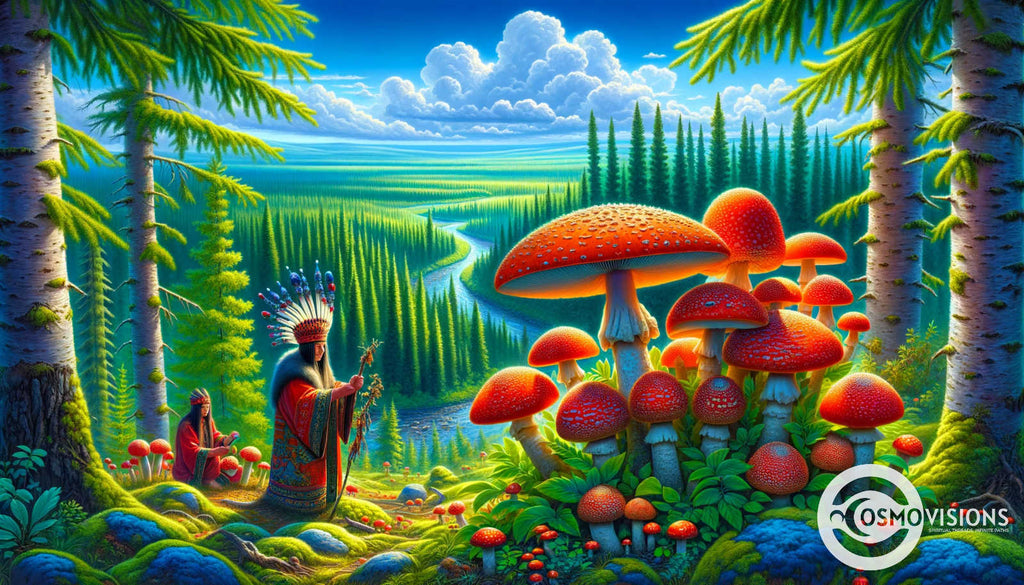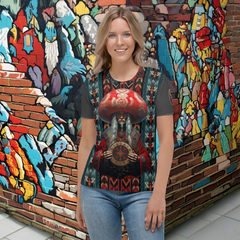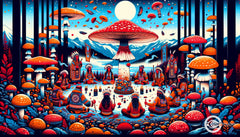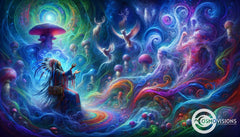The Divine Fungus: How Amanita Muscaria Opens Portals to Mystical Worlds
Posted by Massimiliano Geraci

Across the vast northern forests of Eurasia, a peculiar mushroom has captured the imagination of humankind for millennia. With its vibrant red cap punctuated by white speckles, the iconic Amanita muscaria has long been interwoven with sacred myths and shamanic journeys. modern science reveals that this humble fungus contains visionary compounds that glimpse the cosmic realms of consciousness.
Mythic Origins
While the origins of Amanita muscaria’s relationship with humanity have faded into prehistory, traces emerge in oral narratives and ancient artworks across Northern Asia and Europe. In Siberian cosmology, the mushroom is believed to have descended from the celestial realms, arriving on the back of a fiery meteor. Legends tell of ancient shamans who consumed the divine fungi to gain access to mystical knowledge and communicate with the spirit world.
Ethnobotanical evidence also points to the dependence of reindeer and other northern ungulates on psilocybin mushrooms as a food source. The animals exhibit frenzied, intoxicated behaviors from ingesting Amanita, suggesting an interspecies connection spanning back ages. Some researchers even posit that humans first discovered the visionary powers of mushrooms by observing animal behaviors!
Botanical Description
Amanita muscaria mushrooms have several unique physical features that make identification straightforward. As the common name suggests, the caps (pileus) display a deep red coloration due to acidic pigments that intensify under UV light. White speckles (warts) persist across the cap, spaning 5-20 cm at maturity.
Unlike some mushroom species, Amanita muscaria maintains a symbiotic relationship with the surrounding vascular plants rather than decaying wood. Networks of fungal filaments (mycelium) intertwine with tree roots in a mutually beneficial pact. The mycelium aids the plant by unlocking soil nutrients and shuttling water into thirsty roots. In return, Amanita taps into the plant’s underground energy sources. Five native Eurasian trees - pine, spruce, birch, fir, and larch - host the iconic mushroom.
This symbiosis facilitated A. muscaria’s spread from ancestral homelands near the Arctic Circle to habitats across the Northern Hemisphere. As Siberian tribes migrated eastwards or Europeans explored west to the New World, they carried psilocybin-producing fungi through the transport of colonized tree seedlings. Recent adaptation to southern trees like oak and eucalyptus promises a wider range for the Divine Fungus!

Psychoactive Compounds
The spiritual exaltation and shamanic portals associated with A. muscaria derive from unique neurochemicals within the fungi. Simply ingesting the mushroom transports initiates to visionary dimensions of consciousness.
Ibotenic acid and muscimol constitute the primary psychoactive compounds in the species. While traces occur throughout the fruiting portions, the red cap concentrates the highest levels. Drying or fermenting the mushroom accelerates the conversion of ibotenic acid into muscimol, the more potent psychedelic molecule.
Shamans and spiritual seekers across Eurasia have long manipulated preparation methods to maximize muscimol levels. Traditional customs suggest only eating the dried caps or drinking urine after ingestion. Such rituals enhanced psychotropic effects while mitigating negative issues like nausea.
Binding to the same neurotransmitter pathways as dissociative anesthetics, muscimol alters cognition, emotional processing, and the perception of space/time. Some individuals experience vivid dreaming, out-of-body travel, or profound spiritual insights previously unfathomable in ordinary states of mind. At high doses, complete separation from physical senses manifests - exactly the shamanic tool required for soul flight!
Sacred Traditions of the North
For thousands of years, the divine fungi have been portals to mystical realms of spirit and magic in Northern cultures. Among Siberian peoples like the Kamchadals and Koryaks, Amanita Muscaria facilitated shamanic journeys to heavens and underworlds alike. Even after repression under Soviet rule, the mushroom remains integral to spiritual identity.
Tracking origins proves difficult due to secrecy and lack of written records. Some scholars connect A. muscaria with Soma, a ritual sacrament deified in the ancient Hindu text Rig Veda. Linguistic analysis reveals shared names for the mushroom among Indo-Iranian descendants. Iconography also displays the unmistakable red-and-white speckled caps indicating the Divine Fungus.
Cords to Other Worlds
Siberian shamans rely on the mystical mushroom as a means to achieve trance states. Consuming Amanita before drumming ceremonies launches the spirit from the body into celestial spheres. The initiate may encounter deceased ancestors, animal guides, or patron spirits that offer guidance. Some return with creative inspiration or songs for healing rituals transmitted from mystical beings. Shamans confirm their connection with the vibrant unseen reality permeating the physical world through these vibrant visionary interactions.
The rich shamanic symbology of the fungus persists in myths like the parka adorned with nine rows of Amanita muscaria buttons. Donning this garment transforms the wearer into a great soaring eagle capable of traversing all planes of the cosmos. Legends also tell of magical reindeer who lured Siberian people to the abundant mushroom groves.
Americana
Contact with European explorers facilitated A. muscaria’s spread across the Atlantic to the New World. However, migration even predated human travel, as evidenced by the divergence of Native North American genotypes. Ancestral spores likely crossed the Bering Strait along with peoples and animals before the continents separated. The saintly fungus then adapted relationships with trees like birch, pine, and even oak species.
In the West, some tribes encoded mushrooms into creation stories. certain bands of Nomlaki people in California, for instance, attribute the mountainous landscape formations to rampages by a god intoxicated after consuming divine fungi. Curanderos in Guatemala’s highlands have also reportedly administered Amanita in vision quest rituals passed through generations.
The brilliant red and white color pattern even links the mushroom to celestial bodies among Mesoamerican groups. Where Siberian shamans perceived a connection to the sun and moon, Nahua healers describe the spots as stars in the night sky. Such cosmic symbolism imbues the mushroom with heavenly creative energy.
Mystical Renaissance
While institutional suppression reduced indigenous practices, Amanita maintains an alluring mystical edge, spurring contemporary experimentation. The divine fungi pepper folktales are aimed at children and even Christmas traditions. In Europe, the quintessential red-capped mushroom adorns holiday cards and ornaments as a symbol of merrymaking.
Spreading Yuletide Cheer
As Christmas tradition spread across Europe into the 19th and 20th centuries, Amanita muscaria became indelibly linked to the whimsical winter holiday. Storybook illustrations show Santa Claus wearing the iconic red and white suit first inspired by Siberian shamans gathering the divine mushrooms. Christmas cards soon depicted oversized anthropomorphic Amanita cheerfully trodding through the snow next to evergreens adorned with gifts. The vibrant fungi encapsulated the jovial, mystical essence of the yuletide spirit. Print media disseminated these images of giant smiling mushrooms, ensuring Amanita's enduring connection to Christmas. Once tied to pagan solstice rituals or midwinter shamans, the cheerful red-capped icons now represent holiday nostalgia and the spreading of good cheer.
Amanita Muscaria in Art and Symbolism
The instantly recognizable Amanita muscaria is storied in art and iconography across cultures. Its vibrant red hue and distinctive white flecks make the Divine Fungus a focal point in paintings, sculptures, fabrics, advertisements, and more. Beyond the aesthetic appeal, the mushroom’s ties to mystical realms and its ability to inspire cosmic creativity cement its place as a cultural keystone.
Hallmarks of History
As the quintessential mushroom, artistic representations of Amanita muscaria trace back thousands of years in both the Old and New Worlds. Pre-Christian era petroglyph shards excavated from the Italian Alps display the unmistakable features of the fungi. Figurines and rock paintings in Algerian caves also showcase detailed red caps, suggesting North African roots.
The mushroom’s first known depiction in European religious texts arises in a 1601 botanical work by Flemish artist Charles de l’Écluse. However, the vibrant fungi almost undoubtedly adorned manuscripts and codices of far earlier origin. Once the printing press spread written language to the masses, Amanita became forever linked to fairy tales and Christmas traditions.
Magic and Mysticism
Beyond history books, Amanita muscaria plays a starring role in classic children’s stories, optical illusions, and surrealist painting. The mushrooms serve as homes for forest gnomes, passages to enchanted realms, and whimsical magic symbols. Such wonder and mysticism surrounding the fungus sparks cosmic connections in young minds.
Amanita’s ties to the winter solstice and the Yuletide spirit intertwine through artistic media. Storybook illustrations of Santa’s red suit trimmed in white fur derive from early myths. After imbibing the Divine Fungus, Siberian shamans would purportedly gift mushrooms to reindeer herders through chimneys!
Visionary artists like Fabre de Lagrange and Mati Klarwein also encapsulated mushrooms in seminal works of the psychedelic genres. As cultural touchstones, the paintings display divine creative energy flowing through all forms of nature. Now dispersed internationally through prints and posters, these images became lead symbols of spiritual awakening.
Cosmic Inspiration
Commercial artists readily tap into Amanita’s cosmic essence as well. Vibrant mushroom graphics adorn t-shirts, tattoos, album covers, and event promotions aiming to spark wonder. Russian embroiderers weave the red and white symbolism into traditional handicrafts that preserve spiritual heritage. Haute fashion houses grapple with mimicry through handbags, dresses, and textile prints exuding decadence.
In Mexico, Huichol yarn paintings best showcase the mushroom’s ability to bridge earthly and heavenly domains in sacred art. The intricate wildlife scenes painted across canvas often position Amanita muscaria as a central element. Just as the fungi carry spiritual seekers to shamanic states of consciousness, the Huichol techniques act as worship to ancestral gods. This divine creative inspiration shapes the artisan’s life journey.
As cultures across the globe awaken to the mystical ecology surrounding them, interest in the magical mushrooms can only expand. Amanita Muscaria and its aesthetic brilliance will continue to spark spiritual connections through artistic media for the foreseeable future.

A Portal to the Divine
The very roots of religion and spirituality stem from manifestations of the divine experienced by prophets, shamans, and mystics. Unitive states that dissolve the ego and permeate the heavens deem one a conduit for ethereal knowledge. While devoted spiritual practice can spark such awakenings, the Amanita muscaria mushroom is key to these mystical domains.
As the quintessential entheogen crosses into mainstream awareness, Amanita beckons psychonautic adventurers with her ruby red caps. She gifts us ephemeral glances at eternal Truth through facades built by mortal minds. Those called to Her bosom undergo death and rebirth during passage through these celestial portals.
Visions differ wildly - from cascading kaleidoscopic fractals of sacred geometry to reliving past life memories to floating amongst distant galaxies. Yet all offer momentary liberation from the temporal form. Proper navigation proves crucial when ingesting Amanita muscaria for transdimensional travel.
Charting the Course
Indigenous wisdom passed down generations leads us on this holy pilgrimage. Techniques for harvesting, preparing, and imbibing the mushroom align the sacrament to our vibratory levels. Teas, tonics, or simple dry consumption each shape the upcoming launch. Having maps for exploration ready, with trusted co-pilots, stabilizes turbulent atmospheric fronts.
Of course, exhaustive research on protocols, components, and experiences of others pre-departure eases the interdimensional leap of faith. Studying alkaloid contents, neuropharmacology, and enzymatic breakdown prevents unwelcome mid-voyage surprises. Verifying species identification against poisonous lookalikes also assures a sacred walkabout instead of a trip to the hospital!
Silent darkness and eyeshades boost visions tenfold while calming melodies ease bouts of turbulence during peak ascent. Having companions or a mindfulness practice keeps one tethered if existential panic arises. Trusting in the innate divinity within unleashes the full transformational force conscious walls crumble!
Heavenly Harvest
Mycelial messages bubble up from Gaian underpinnings once the ego dissolves fully; our planet yearns to buoy our blossoming spiritual revolution! As the mushroom journey culminates, cosmic energies coalesce and embed symbols, insights, and sensations into fiber of being.
By surrendering control, we allow ecstatic currents to rewire neural corridors now opened to grace. Each voyage gifts emergent archetypal guides, bodhisattva vows, creative channels, and the embodiment of divinity through self-reflection. Aligning with plant deva spirits teaches the preciousness of even supposed poison!
Of course, revelations fade just as astroglide through the kingdoms of organisms, elements, and light retreat with the fading effects. What remains forms that which to build upon - beauty, wisdom, inspiration, purpose, humility, gratitude, and above all, AWE for the sacred Mystery beholden behind all forms.





















